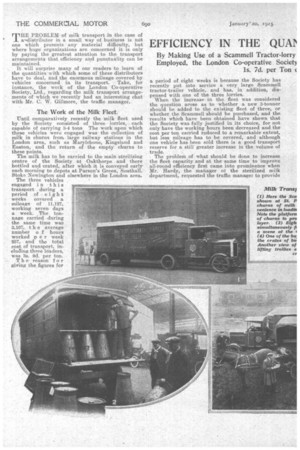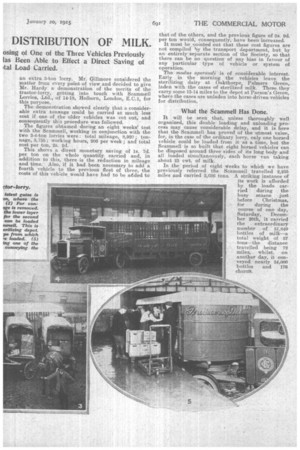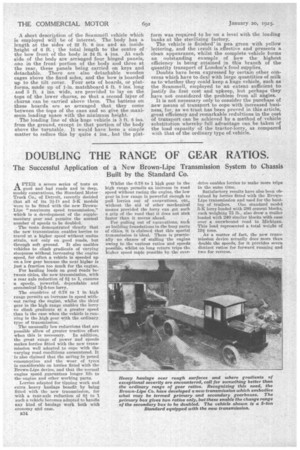EFFICIENCY IN THE QUA DISTRIBUTION OF MILK.
Page 16

Page 17

Page 18

If you've noticed an error in this article please click here to report it so we can fix it.
By Making Use of a Scammell Tractor-lorry Employed, the London Co-operative Society
is.7d. per Ton
osing of One of the Three Vehicles Previously [as Been Able to Effect a Direct Saving of ital Load Carried.
THE PROBLEM of milk transport in the case of a—distributor in a small way of business is not one which presents any material difficulty, but where huge organizations are concerned it is only by paying the greatest attention to the transport arrangements that efficiency and punctuality can be
maintained. '
It will surprise many of our readers to learn of the quantities withwhich some of these distributors have to deal, and the enormous mileage covered by vehicles concerned in its transport. Take, for instance, the work of the London Co-operative Society, Ltd., regarding the milk transport arrangements of which we recently had an interesting chat with Mr. C. W. Gillmore, the traffic manager.
The Work of the Milk Fleet.
Until comparatively. recently the milk fleet used by the Society consisted of three lorries, each
capable of carrying 3-4 tons The work upon which these vehicles were engaged was the collection of milk in churns from large railway stations in the London area, such as Marylebone, Kingsland and Euston, and the return of the empty churns to these points. The milk has to be carried to the main sterilizing centre of the Society at Oakthorpe and there bottled and crated, after which it is conveyed early each morning to depots at Parson's Green, Southall. Stoke Newington and elsewhere in the London area. The three vehicles .
engaged in •t his transport during a period of eight weeks covered a mileage of 11,127, working seven days a week. The tonnage carried during the same time wa,s 3,167, t h e average number o f hours worked p e r week 257, and the total cost of transport, including three loaders, was 3s. 9d. per ton.
The reason for giving the figures for a period of eight weeks is because the Society has recently put into service a very large Scammell tractor-trailer vehicle, and has, in addition, dispensed with one of the three lorries. When the increase in the fleet was considered the question arose as to whether a new 3-tonner should be added to the existing fleet of three, or whether the Scammell should be purchased, and the results which have been obtained have shown that the Society was fully justified in its choice, for not only have the working hours been decreased and the cost per ton carried reduced to a remarkable extent, but less mileage has to be covered, and although one vehicle has been sold there is a good transport reserve for a still greater increase in the volume of trade.
The problem of what should be done to increase the fleet capacity and at the same time to improve all-round efficiency first came into prominence when Mr. Hardy, the manager of the sterilized milk department, requested the traffic manager to provide an extra 3-ton lorry. Mr. Gillmore considered the matter from every point of view and decided to give Mr. Hardy a demonstration of the merits of the tractor-lorry, getting into touch with Scammell Lorries, Ltd., of 14-18, Holborn, London, E.C.1, for this purpose.
The demonstration showed clearly that a considerable extra tonriage could be carried at much less cost if one of the older vehicles was cut out, and consequently this procedure was followed.
The figures obtained during an eight weeks' test with the Scammell, working in conjunction with the two 3-4-ton lorries were : total mileage, 8,920; tonnage, 3,755; working hours, 206 per week ; and total cost per ton, 2s. 2d.
This sho,.vs a direct monetary saving of is. 7d. per ton on the whole quantity carried and, in addition to this, there is the reduction in mileage and time. Also, if it had been necessary to add a fourth vehicle to the previous fleet of three, the costs of this vehicle would have had to be added to
that of the others, and the previous figure of 3s. 9d. per ton would, consequently, have been increased.
It must be .'pointed out that these cost figures are not compiled by the transport department, but by an entirely separate section of the Society, so that there can be no question of any bias in favour of any particular type of vehicle or system of operation. The modus operandi is of considerable interest. Early in the morning the vehicles leave the sterilizing dairy at Oakthorpe, Palmers Green, laden with the cases of sterilized milk. These they carry some 13-14 miles to the depot at Parson's Green, where the cases are unladen into horse-driven vehicles for distribution. •
What the Scammell Has Done.
It will be seen that, unless thoroughly well organized, this double loading and unloading process may cause considerable delay, and it is here that the Scammeli has proved -of the utmost value, for, in the case of the ordinary lorry, only one horsed vehicle could be loaded from it at a time, but the Scammell is so built that eight horsed vehicles can be disposed around three sides of its long body and all loaded simultaneously, each horse van taking about 25 cwt. of milk.
In the period of eight weeks to which we have previously referred the Scammell travelled 2,255 miles and carried 2,036 tons. A striking instance of its work is afforded by the loads carried during the bus' season just
before Christmas, for during the course of one day, Saturday, December 20th, it carried the extraordinary number of 51,840 bottles of milk—a total weight of 57 tons—the distance travelled being 72 miles, whilst, on another day, it conveyed nearly 34,000 bottles and 176 churn's. A short description of the Scaminell vehicle which is employed will be of interest. The body has a length at the sides of 22 ft. 6 ins. and an inside height of 6 ft. ; the total length to the centre of the bow front of the body is 24 ft. 4 ins. At each side of the body are arranged four hinged panels, one in the front portion of the body and three at the rear, these panels being carried on keys and detachable. There are also detachable wooden cages above the fixed sides, and the bow is boarded up to the tilt cover. Four sets of boards, or platforms, made up of 1-in. matchboard 6 ft. 8 ins long and 3 ft. 4 ins, wide, are provided to lay on the tops of the lower churns, so that a second layer of churns can be carried above them. The battens on these boards are so arranged that they come between the tops of the cans and so give the maximum loading space with the minimum height.
The loading line of this huge vehicle is 3 ft. 8 ins. from the ground, except in that portion of the body above the turntable. It would have been a simple matter to reduce this by quite 4 ins., but the plat
form was required to be on a level with the loading banks at the sterilizing factory.
The vehicle is finished in pea green with yellow lettering, and the iesult is effective and presents a clean appearance, whilst the complete vehicle forms an outstanding example of how the highest efficiency is being attained in this branch of the quantity transport of London's food supplies.
Doubts have been expressed by certain other concerns which have to deal with large quantities of milk as to whether they could keep a huge vehicle, such as the Scamrnell, employed to an extent sufficient to justify its first cost and upkeep, but perhaps they have not considered the problem from all angles. It is not necessary only to consider the purchase of new means of transport to cope with increased business, for, as we trust has been proved in this article, great efficiency and remarkable reduttions in the cost of transport can be achieved by a method of vehicle substitution whereby full advantage can be taken of the load capacity of the tractor-lorry, as compared with that of the ordinary type of vehicle.






























